By Bob Tisdale on Watts Up With That
The Seth Borenstein AP article about the recent high sea surface temperature is misleading. There is a significant difference between what Seth Borenstein reported and what NOAA stated in the July “State of the Climate”.
Borenstein does not clarify that it is a record for the month of July, where NOAA does. NOAA writes, “The global ocean surface temperature for July 2009 was the warmest on record, 0.59C (1.06F) above the 20th century average of 16.4C (61.5F). This broke the previous July record set in 1998.” Refer to Figure 1, which is a graph of SST for July from 1982 to 2009 (NOAA’s ERSST.v3b version).
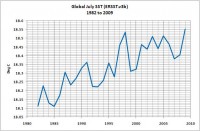
Borenstein readers are told that July 2009 Sea Surface Temperatures (SSTs) were the highest since records began, but that is false. Figure 2 illustrates monthly SSTs from November 1981 to July 2009. I’ve added a red horizontal line to show the July 2009 value.
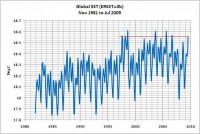
Whether or not July SSTs represented a record is also dependent on the SST dataset. NOAA’s satellite-based Optimally Interpolated (OI,v2) dataset presents a different picture. That dataset clearly shows that July 1998, Figure 3, had a higher SST.
The Borenstein article also claims that Arctic SST anomalies are as high as 10 deg F (5.5 deg C) above average. Wow!! Really??
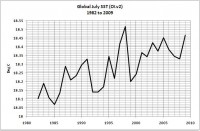
And looking at the monthly OI.v2 data since November 1981, Figure 4, there are numerous months with higher SSTs.
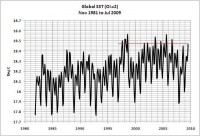
The Borenstein article also claims that Arctic SST anomalies are as high as 10 deg F (5.5 deg C) above average. Wow!! Really??
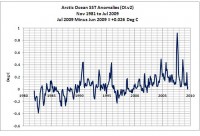
See larger here.
SST anomaly graphs through July 2009 for the Arctic Ocean and other individual oceans can be found at my July 2009 SST Anomaly Update.
To sum up the Borenstein article, itís factually incorrect in places, and in others, it raises alarmism to ridiculous levels by dwelling on a meaningless statistic, the July SST anomaly of the White Sea. See full post here.
See Anthony’s excellent post on “Diane Feinstein, Turbidity Denier” here.
By Alan Caruba
To understand how insane the Cap-and-Trade bill really is you need to know that it based on the belief that carbon dioxide emissions must be reduced to avoid a global warming that is NOT happening.
The American Clean Energy and Security Act is a giant scam involving “carbon credits” to be sold and traded. It is also about billions in taxpayer’s dollars being wasted on wind and solar generation of electricity. If this was a sensible way to produce energy, it would be a dominant producer, but it isn’t. Short of producing electricity by peddling bicycles, it is as inefficient and impractical as possible.

So-called “clean energy” accounts for just over one percent of all the electricity Americans use every day and it exists only because the government subsidizes it by taking your tax dollars and giving them to wind and solar energy producers. Some States require utilities to buy electricity from them.
As for “security”, how much energy security does the United States enjoy if it must import 60% of the oil it uses for transportation and a wide range of products, not the least of which is anything made from plastic?
Real security means drilling and mining right here, right now. There’s plenty of oil in ANWR and offshore. The government forbids access to it. And, where’s there’s oil there’s natural gas as well. As for coal, the U.S. has enough for centuries of affordable electricity, but the environmental organizations have in recent years stopped the building of a hundred coal-fired plants and they brag about it.
A study of the economic impact of the bill by the American Council on Capitol Formation and the National Association of Manufacturers concluded that, if passed, Cap-and-Trade would decrease the Gross Domestic Product of the United States by $2 and $3 trillion by 2030. That’s lost job and lost industrial production.
That’s because Cap-and-Trade would increase the cost of all activities, business and others, by increasing the cost of electricity, the master resource that powers everything in the nation.
Remember, this would be done to limit “greenhouse gas emissions.” This cost would solely be on the backs of Americans while other nations of the world would be free to continue emissions, i.e. providing jobs and producing goods.
Remember, too, that global warming is not occurring. The Earth has been in a cooling cycle for a decade.
This bill is so horrible, Americans can only guess at the consequences of its passage. One thing is certain. It would massively expand government because thousands would have to be hired to administer it.
The nonpartisan Congressional Budget Office estimates it would cost $8 billion over a ten-year period because to operate efficiently it would require the approval of approximately 1,500 new regulations and mandates involving at least 21 federal agencies.
The introduction of Cap-and-Trade would “create the nation’s largest commodity market in which polluters would buy and sell rights to emit carbon dioxide” according to a recent Washington Times article, but it is essential to understand that emitting CO2 is not “pollution.” Carbon dioxide is NOT a pollutant. It is a gas vital to all plant life on Earth. If CO2 were a pollutant, than surely oxygen is as well because oxidation causes rust.
The Cap-and-Trade’s carbon credits could “be a $2 trillion market within five years,” said Bart Chilton, commissioner of the Commodities Futures Trade Commission.
So Cap-and-Trade is NOT about greenhouse gases or global warming. It is about trading credits for the right to GENERATE or USE ENERGY.
How insane is that?
Keep in mind that the present financial crisis is the direct result of the GOVERNMENT getting into the mortgage loan market in the form of Fannie Mae and Freddie Mac, purchasing loans from banking institutions and mortgage lenders who were required by law to make bad loans. Those loans, in turn, were “bundled” and resold as assets, but they were worthless.
Nothing is more worthless than carbon credits. Nothing is more dangerous to the economic future of the nation than the Cap-and-Trade Act. The U.S. Senate must defeat this bill which has already been passed by the House. YOU must defeat this bill by demanding your Senators vote against it. See Alan’s blog post here.
-----------------------------
Cap and Rage
The fight over health-care reform could hobble climate-change legislation
Washington Post Editorial
THE RANCOROUS debate over health reform has given voice to considerable uneasiness among Americans. Many are worried about how a new system will be paid for in an economy that has unraveled, and they are anxious about a kudzu-like expansion of an already unwieldy bureaucracy. Given the herculean effort it will take to get President Obama’s vision of reform through Congress, we’re not convinced that the Senate will have the stomach to tackle cap-and-trade legislation this fall. The growing agitation within the chamber over the creation of another complex system to buy, sell and trade pollution credits only adds to our doubts.
The House barely passed the American Clean Energy and Security Act (a.k.a. Waxman-Markey) in June. The 1,400-page bill has a potpourri of measures ranging from new efficiency and renewable energy standards to a cap-and-trade provision that gives away 85 percent of the pollution allowances to various interests. The Senate is proving to be a much tougher sell. Last week, four Democratic senators—Blanche Lincoln (Ark.), Ben Nelson (Neb.), Kent Conrad (N.D.) and Byron L. Dorgan (N.D.)—called on the leadership to strip cap-and-trade completely from the bill that Majority Leader Harry M. Reid (D-Nev.) hopes to start stitching together next month. This comes days after 10 moderate Democratic senators from coal and manufacturing states sent a letter to President Obama warning that they would not go along with any cap-and-trade regime that didn’t “maintain a level playing field for American manufacturing.”
Dropping cap-and-trade from the Senate bill is considered a non-starter by Mr. Reid and environmental advocates for two reasons. First, a long-stated goal of congressional leaders and the president himself is to have emissions-limiting legislation passed and signed into law in time for international climate talks in Copenhagen in December. Second, there is no Plan B. The leadership has put all of its eggs in the cap-and-trade basket.
Yet there are other options worthy of consideration. Yes, we’re talking about a carbon tax. It would be relatively simple to devise and easy to implement. It would require no new bureaucracy, and the revenue generated could be rebated to the taxpayer in any number of ways—through a payroll tax reduction, for instance.
We know we are running counter to Washington’s tax-averse conventional wisdom. But we are not alone in our support of the carbon tax. There were three such bills in the House. One of the inventors of the cap-and-trade concept, Thomas Crocker, told the Wall Street Journal last week that he favors a carbon tax because he believes it’s easier to enforce.
If Congress fails to pass cap-and-trade legislation, it will rapidly approach a fork in the road in addressing global warming. Members can sit back while unelected bureaucrats at the Environmental Protection Agency follow through on their moves toward regulating greenhouse gas emissions as a pollutant under the Clean Air Act. Or they can entertain a carbon-based tax designed to reduce emissions and give the money back to taxpayers in an equitable manner. A decision on which path to take is bearing down upon us. Not only are the global warming dangers facing the planet reaching the tipping point, but there will also be no climate agreement in Copenhagen without strong leadership in words and deeds from the United States. As the Senate forges ahead, nothing should be off the table. Read post here.
-----------------------------
The relative electrial energy potential of various sources thanks to Bill DiPucchio. Larger version here. It clearly shows why wind and solar must be considered supplemental sources in any sane energy plan.
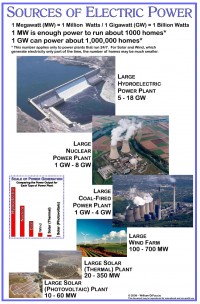
See Peter Lang’s analysis of the realities about wind power here and solar here. See this new site devoted to the promising new energy sources and folly of some of the alternatives endorsed by the environmental lobby and administration. There are 30 posts over the last few months.
By Peter Hannaford on SPPI
America’s “mainstream” media missed it, but April 17 was a red-letter day for its Deep Ecologists. Red letter because it was the day the Obama Administration declared that carbon dioxide and five other gases emitted by industry threaten “the health and welfare of current and future generations.” This opens the door to regulations by the Environmental Protection Agency to “cap” emissions. The Deep Ecologists see this as the path to their cherished dream of a less populous nation with greatly reduced industrial production. It will also lead to a poorer (they would call it “simpler") standard of living.
The Deep Ecologists’ philosophy came together in 1973 with a treatise by a Norwegian philosopher, Arne Naess. He and his followers disdained the “utilitarian” environmentalists who, up to that time, had been working on clean air or water and saving this or that species. The facts of science and logic were not enough, he believed. They lacked an ethical framework that required deep questioning and commitment. Naess said that humans didn’t rank above other creatures. That is, “the right of all forms [of life] to live is a universal right which cannot be quantified. No single species of living being has more of this particular right to live and unfold than any other species.”
In this, Naess and his followers resembled the mid-19th century pantheists who believed that all species were interrelated. For example, they called fish, “the finny tribe.” The Deep Ecologists went well beyond this romantic view. In a 1985 book, two of them, W. Devall and G. Sessions, spelled out eight principles the world should live by. Here is Number Four: “The flourishing of human life and cultures is compatible with a substantial decrease of the human population.” Number Five reads, “Present human interference with the non-human world (flora and fauna) is excessive, and the situation is rapidly worsening.” It leads to Number Six: “Policies must therefore be changed. These policies affect basic economic, technological and ideological structures. The resulting state of affairs will be deeply different from the present.”
The Deep
Ecologists see this as the path to their cherished dream of a less populous nation with greatly reduced industrial production. It will also lead to a poorer (they would call it “simpler") standard of living. Whether they admit it or not, most active environmentalists believe in the Deep Ecology thesis that mankind has despoiled the land, misused natural resources, and is greedy and wasteful. (A friend once said of the Sierra Club, “It believes that mankind is but a passing disaster on this planet.")
Deep Ecology has been the underlying drive of Green Parties and the rush to declare Global Warming a coming disaster. This, despite the fact, as Steve Milloy puts it in a new book, “the fatal flaw of global warming alarmism is that there is no scientific evidence indicating that carbon dioxide, much less man-made carbon dioxide emissions, control or even measurably impact global climate.” (Green Hell: How Environmentalists Plan to Control Your Life and What You Can Do to Stop Them. Regnery Publishing.)
Global Warming hysteria is based on hypothetical computer models that have never been validated against real world experience. The fact that many scientists accept the hypotheses does not make them true. For that matter, many scientists actively dispute those same hypotheses. The EPA’s license to cap emissions may take some time to play out through such things as a carbon tax ("cap and trade"). Once it does, this would serve another of Obama’s objectives, income redistribution. As the carbon tax is imposed on industry, the cost to consumers of most goods and services will go up. The administration would use the tax receipts to provide “rebates” to lower income households to soften the effect.
In time, the coming regimen will decide what kind of car you will drive, what kind of house you live in and what kind of products you’ll buy. Congress, in response to pleas from various affected interests, may soften the plan around the edges, but will not stop it in its tracks. The Deep Ecologists have worked for nearly four decades silently but persistently through many environmental organizations to reach what they consider to be Utopia. You and your neighbors may decide it is more like Hell. Download pdf here.


